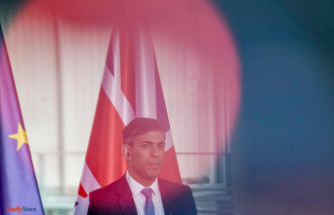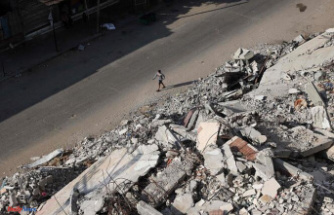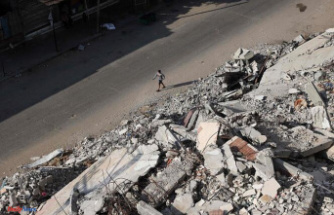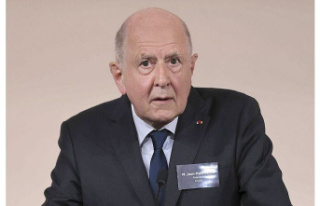After Ukraine appealed for drones, dozens of people donated their commercial and hobby drones to Ukraine.
The country also needs money to purchase 200 military reconnaissance drones.
Both the Russian and Ukrainian forces have used small consumer drones, also called unmanned aerial vehicles (UAV).
Justin Bronk, Royal Unite Services Institute (RUSI), says that small drones can be useful but that tactics are being developed to counter them.
He says that small and large drones can give him a live view of enemy positions.
He said that both sides in Ukraine were able to quickly exploit the real-time video picture to call down artillery fire, and quickly correct it to make it very precise, even when using unguided artillery on enemy forces."
He warned that electronic countermeasures are becoming more effective.
According to Ukraine, the proposed army of drones involves complex procurement, maintenance, and replacement as well as pilot training.
Colonel Oleksii Noskov, assistant commander in chief of Armed Forces of Ukraine, stated that the 'army of drones will enable us to continuously monitor the 2,470km (1,530-mile-long) front line and to respond to enemy attacks using modern technology.
Mykhailo Fedorov (Ukraine's minister for digital transformation) told BBC via email that the campaign's first goal was to buy tactical drones with a 160km (100mile) range. They are also equipped with GPS, mapping tools, and sophisticated camera and GPS technology.
After studying the issue, he stated that "our team understood" that Ukraine still required quadcopters and that he was asking for donations.
Ukraine plans to acquire thousands of multi-use UAVs for commercial and military purposes.
Two warehouses in Poland and the United States are donating drones that meet minimum standards to Ukraine.
Fedorov also encourages companies to participate: "This project offers a great opportunity to drone manufacturers to test and evaluate their equipment under harsh conditions," Fedorov wrote.
According to Mr Fedorov's tweet, the campaign launched Friday raised 200m UAH (PS5.7m), which enabled two military UAVs and dozens more small drones to be purchased.
According to Mr Bronk the military "warmate" drones are a type loitering munition made in Poland. According to the company's website, the drone is "a good alternative to anti-tank guided missiles".
Mr Fedorov claims that drones for hobby or commercial use have proven their worth on the battlefield.
Russia also made use of them.
Mr Fedorov had earlier this year called upon DJI, the market leader, to stop selling drones in Russia.
DJI, a Chinese company, halted Russian and Ukrainian sales.
Fedorov stated that Russia is using commercial drones for reconnaissance and strikes in unprovoked, unfair war.
"It was crucial that DJI, the largest commercial drone-maker in the world, stopped selling in Russia."
Valerii Iakovenko co-founder of DroneUA in Ukraine told BBC News that DJI had increased Ukraine's costs while Russia could still obtain drones via Belarus.
His company, a majority farmer-based, supplied drones and robots to the government ever since before the war, he stated.
He said that drones were among the most desired technology along with Elon Musk’s Starlink satellite internet network and professional radio equipment.
Even small ones are useful for providing field data, locating enemy soldiers and correcting artillery firing.
"A large number of volunteers that joined the Ukrainian forces are also making an impact," Mr Iakovenko stated.
"Drone pilots with small consumer drones provide aerial intelligence across the entire front line.
"It's all about speed of information exchange between field staff and general staff to be able to take decisions nearly immediately.
RUSI technology expert Mr Bronk said that Ukrainians have been particularly inventive in finding ways of sourcing and using commercial and military grade drones. He also mentioned how they were used as improvised loitering munition to strike targets at considerable distances. Recently, a Rostov oil refinery was equipped with a UAV commercial grade with an improvised warhead.
He warns that tactics are changing.
"What has happened in Donbas over the past few months is that the Russians have been able to consolidate their electronic warfare assets and integrate these well with their ongoing operations.
According to Mr Bronk, every time Ukraine sends up a small UAV via radio remote control, "the Russian electronic warfare kits picks it up immediately and either takes it over, or cuts the command line electronically and forces it back".
Remote control drones cannot fly over moving targets. Instead, small drones must be programmed to follow a route and identify targets when they return. He said that this slow process has limited value for moving targets.
Bronk believed that Ukraine needed loitering munitions that could target and attack Russian electronic warfare systems.
Although hobbyist drones are useful, "grassroots support in the generation of military equipment is likely to be as valuable in terms of morale as for those who are contributing"












